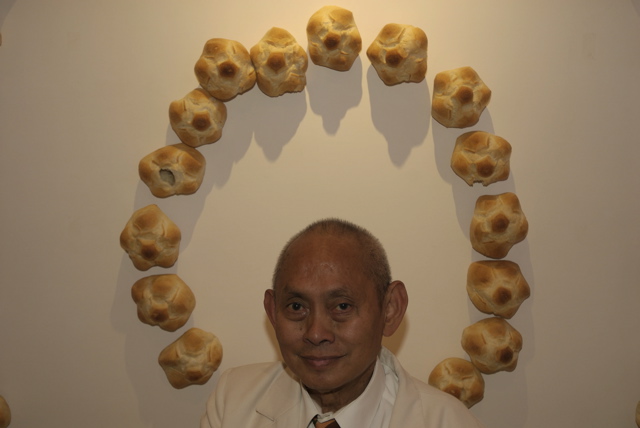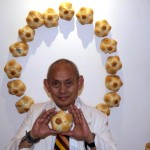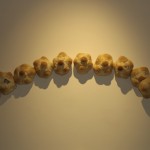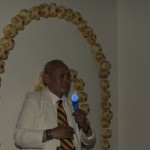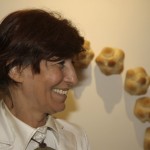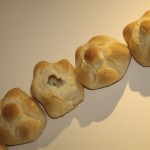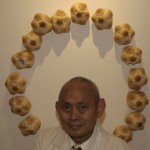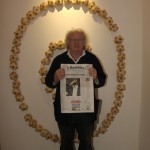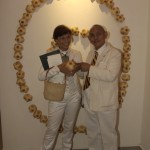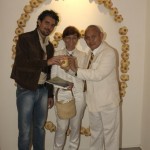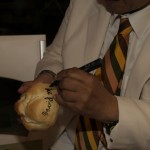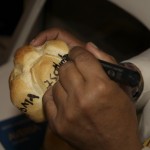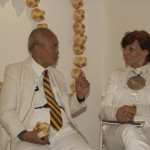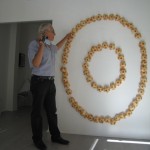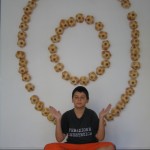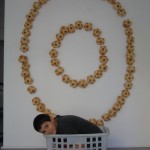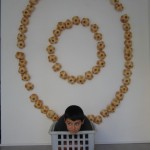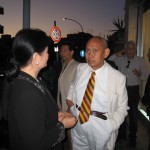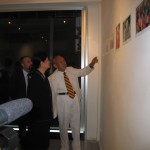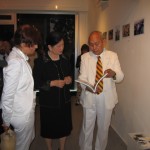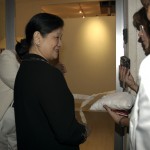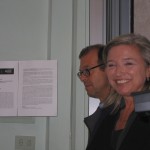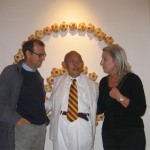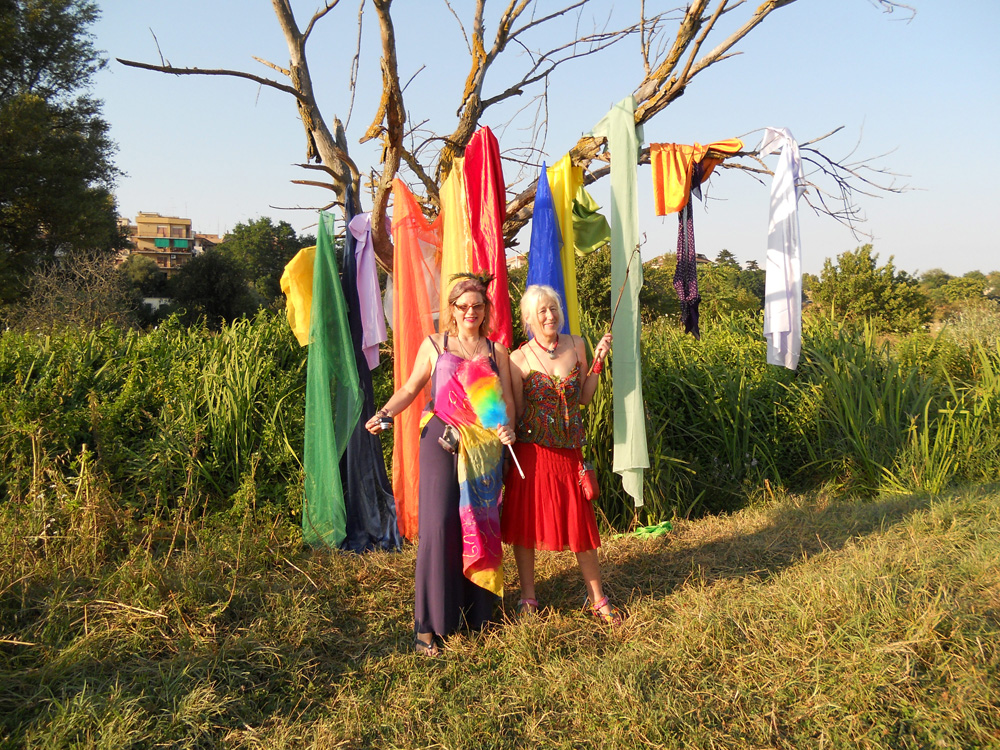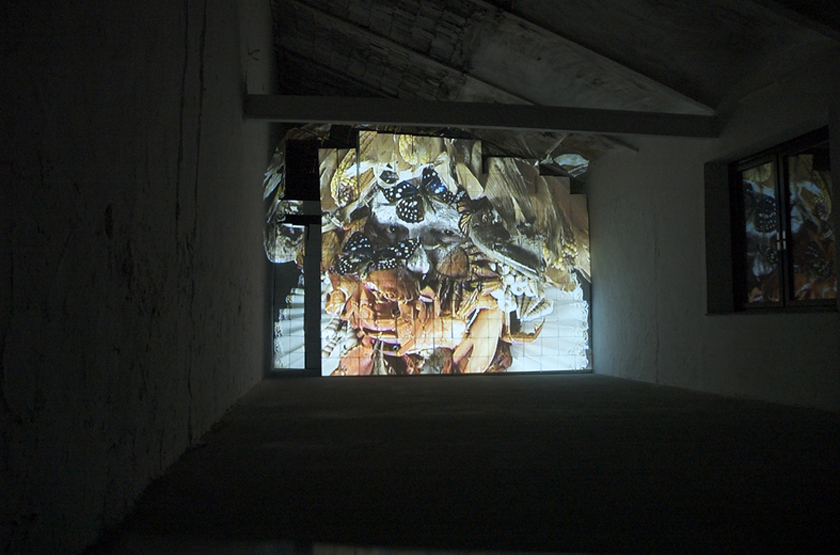in collaborazione con: Vittoria Biasi, RO.MI arte contemporanea, Factory Riva Ostiene e Gruppo Sinestetico
presenta
David Medalla
nell’evento “URBI ET ORBI”
per la Notte Bianca a Roma 6-7-8 Settembre 2007
David Medalla, Fontana, Soto, Elswort Kelly, Gruppo N, Dorazio, Castellani, Manzoni con altri artisti, provenienti da diverse aree geografiche e culturali, sono invitati da Uto Kultermann negli anni ’60 nelle mostre sulla monocromia bianca.
La linea bianca che segna la demarcazione verso la seconda metà del secolo introduce una vibrazione di creatività e trasformazione socio-politico e artistico. Nelle mostre di Leverkusen che sottolineano il coinvolgimento di numerosi artisti attorno ai linguaggi del bianco, Medalla introduce il sogno, l’incanto e il mistero della vita che pulsa nella materia. Nella serie Cloud Canyons, l’artista propone l’opera scultorea realizzata con sapone emulsionato nell’acqua: è la metafora del mare, del cielo, della terra. L’idea della totalità, del principio del tutto si compone tra titolo e opera, dove il primo diviene estensione dell’altro. La simbologia naturale entra nel mondo da cui discende l’opera.
Guy Barret pone in rapporto le storie del venezuelano Soto e del filippino Medalla, per le innovazioni apportate nell’arte scultorea, iniziata nel centro d’arte londinese Signals. Lo storico propone la ricostruzione dei legami, delle relazioni tra la storia personale, la ricerca artistica e il panorama culturale del tempo, per riflettere sulla convinzione eurocentrica che considera l’avanguardia un fenomeno occidentale.
In tal senso David Medalla ha inseguito l’estremo linguistico della creatività in una corrispondenza tra arte vita secondo un concetto di arte totale. La poetica delle sue performance è guidata da segni minimi, impronte di un oltre coinvolgente.
L’artista, fondatore e direttore della LONDON BIENNALE, presenterà un dittico di performance il 7 e l’8 settembre 2007, dal titolo “URBI et ORBI”
in ricordo della frase latina
con la quale gli imperatori romani
e poi i Papi si sono rivolti ai cittadini di Roma e agli abitanti del mondo.
Il 6 settembre, sul Gianicolo, sotto la quercia di Torquato Tasso, Raffaella Losapio, David Medalla prepareranno il video in omaggio al personaggio leggendario di Garibaldi e sua moglie Anita. Sarà una conversazione sotto la quercia del Tasso, leggendo un giornale con informazioni dal mondo e dall’Argentina, facendo fluire la storia tra presente e passato, con possibili deformazioni sonore, come nella poesia sperimentale degli anni ‘60.
Il ritorno è un coinvolgimento emotivo e artistico con la rilettura o reinterpretazione di quanto realizzato nel luogo secondo i nuovi spostamenti dell’anima. Medalla è considerato un artista nomade dell’arte o un magicièn de la terre. Non si confronta con un concetto statico di memoria continuando a sentire il tutto in modo vibrazionale.
La prima performance di David Medalla avverrà il 7 Settembre, dalle ore 20 alla Galleria studio.ra, dove Medalla presenterà anche i video con i discorsi estemporanei sui sette colli di Roma, rievocando le splendide improvvisazioni eseguite durante i precedenti soggiorni nella Città Eterna nel 1962, 1979-80 e 2002-3. L’ improvvisazione del 1980 intitolata ‘MEDALLA SALUTA ROMA’ ebbe luogo sulle orme tracciate dalla British School e nel libro ‘Exploding Galaxies: The Art of David Medalla’ di Guy Brett, pubblicato da Kala Press, a Londra, nel 1975, vi è riportata una foto a colori di quell’evento.
Presenzierà l’Ambasciatore delle Filippine Leonida L. Vera.
Un’altra performance di David Medalla avrà luogo presso la ‘Factory’ di Via Riva Ostiense (sponda sinistra), l’8 settembre 2007 dalle ore 21. Queste due performance correlate e interattive saranno caratterizzate dalla creazione di due sculture effimere su vasta scala con la partecipazione del pubblico. Nell’ultimo soggiorno a Roma nell’autunno del 2002, Medalla creò insieme all’artista australiano Adam Nankervis (fondatore e direttore del Museum Man – www.museumman.org) un discorso estemporaneo sul colle Capitolino a Roma usando le iniziali ‘U’ e ‘O’ (che stanno per “Urbi et Orbi”) , parte della loro serie di graffiti globali per gli Archivi di Storia Segreta del Mondrian Fan Club, che hanno co-fondato nel 1973 a New York. L’evento è documentato con una fotografia dell’improvvisazione inserita nella rivista HOY pubblicata a Londra nel 2003. Sulla traccia dell’ultimo evento, sull’estremo di una formula, utilizzando la prima lettera, Medalla inviterà a realizzare una grande scultura della lettera ‘U’, come Urbi, formata da blocchi di ‘tufo’, argilloso come la terra, e da detriti vari che l’artista e i partecipanti romani raccoglieranno sui sette colli di Roma durante il suo discorso estemporaneo. La seconda scultura avrà la forma della lettera ‘O’, come Orbi, e sarà formata da un assemblaggio di preziose ‘rosette’ mezze mangiate. La rosetta è il tipico panino romano a forma di rosa. I panini saranno offerti al pubblico durante la performance. I panini smangiucchiati, con le impronte delle dentiere e dei denti, diventeranno la scultura-assemblaggio a forma di ‘O’.
Due lettere dai ‘Sonnet of the Vowels’ di Arthur Rimbaud giocano anche una parte importante nella struttura del dittico di performance di Medalla, tanto quanto (nel caso della prima performance) nel metodo dell’obliterazione praticata dallo scrittore Georges Perec del gruppo ‘Oulipo’, e nel metodo dell’‘assisting ready made’ sperimentato per primo da Marcel Duchamp. Il dittico di performance di David Medalla mette in relazione il concetto della città in arte e in letteratura e le realtà multiple delle differenti vite dei cittadini nel mondo di oggi. Essi sono i più recenti esempi di arte sinotticarealista che David Medalla sperimentò per primo negli anni Settanta. Le foto delle ultime performance romane, che sono aperte al pubblico, saranno successivamente pubblicate sul sito web www.studiora.eu.
Vittoria Biasi
with the collaboration of: Vittoria Biasi, Association RO.MI contemporary art, Gruppo Sinestetico, Factory Riva Ostiense
presents
David Medalla
in the event “URBI et ORBI”
for the White Night in Rome 6-7-8 September 2007
David Medalla, Fontana, Soto, Elswort Kelly, N Group, Dorazio, Castellani, Manzoni with other artists, coming from different geographical and cultural areas, are invited to Uto Kultermann in the sixties at the exhibitions on the white monochrome. The white line that draws the demarcation by the second middle of the century introduces a quiver of the creativity and a social, political and artistic transformation. At the exhibitions of Leverkusen that underline the participation of several artists about the languages of the white, Medalla introduces the dream, the fascination and the mistery of the life that throbs in the matter. In the serial Cloud Canyons, the artist proposes the sculptural work realized with soap emulsified inside the water: it is the methaphor of the sea, of the sky, of the ground. The idea of the totality, of the origin of everything consists of title and work, where the first becomes extension of the other. The natural symbology goes into the world from which the work comes from. Guy Barret compares the stories of the Venezuelan Soto and of the Filipino Medalla, for the innovations introduced in the sculptural art, started at the centre of London art Signals. The historian proposes the reconstruction of the bonds, of the connections between the personal story, the artistic research and the cultural scene of the time, for reflect upon the Eurocentric convinction that considers the avant-garde a Western phenomenon. In that sense David Medalla has pursued the linguistic extreme of the creativity in a correspondence between art and life according to a concept of total art. The poetics of his performances is led by minima signs, marks of a fascinating past.
The artist, founder and director of the LONDON BIENNALE, will present a diptych of performances in Rome, Italy, on September 7 and 8, 2007; it is entitled ‘URBI et ORBI‘, as a memento of the Latin phrase with which the ancient Roman Emperors and subsequently the Popes addressed the citizens of the city of Rome and the inhabitants of the world.
On the 6th of September, at the Gianicolo, under the oak of Torquato Tasso, Raffaella Losapio, David Medalla will prepare the video to honour the legendary figure of Garibaldi and his wife Anita. It will be a conversation under the oak of Tasso, reading a newspaper with information from all the world and from Argentina, letting flow the history between present and past, with possible sound deformations, as for the experimental poetry of the sixties. The return is an emotional and artistic involvement with the rereading and reinterpretation of that realized in the place according to the new displacements of the soul. Medalla is considered a nomadic artist of the art or a magicièn de la terre. He doesn’t compare with a static concept of memory, he continues to feel everything in a vibrational way.
David Medalla’s first performance
will take place on September 7 at the Gallery studio.ra where Medalla will feature the videos with the impromptus on the seven hills of Rome, recalling the magnificent impromptus he made in the Eternal City during his previous sojourns there: in 1962, 1979-80, and 2002-3.
The impromptu of 1980
entitled ‘MEDALLA SALUTA ROMA‘
took place on the steps leading to the British School and in the book ‘Exploding Galaxies: The Art of David Medalla‘ by Guy Brett, published by Kala Press, London, in 1975 where there is a colour photograph of that event.
David Medalla’s another performance will take place at ‘The Factory’ at Riva Ostiense, on September 8, 2007. These two inter-related inter-active performances will feature the making of two large-scale ephemeral sculptures with the participation of the audience. During Medalla’s last sojourn in Rome in the autumn of 2002, he created with Australian artist Adam Nankervis (founder and director of Museum Man – www.museumman.org) an impromptu on the Capitoline Hill in Rome using the initials ‘U‘ and ‘O‘ (for ‘Urbi et Orbi‘) which was part of their continuing series of global graffiti for the Archives of the Secret History of the Mondrian Fan Club which they co-founded in 1973 in New York. A photograph of that impromptu was featured in the magazine HOY published in London in 2003. On the track of the last event, on the extreme of a formula, using the first letter, Medalla will invite to realize a big sculpture in the form of a large letter ‘U‘ (for ‘Urbi‘) which will be made from the clods of ’tufa’ (clay-like earth) and assorted debris which the artist and Roman citizens will gather on the seven hills of Rome during his impromptus.
The second sculpture will be in the form of the letter ‘O‘ (for ‘Orbi‘) which will be made from an assemblage of half-eaten golden ’rosadas‘, the rose-shaped Roman buns.
The buns will be offered to the audience during the performance. The half-eaten buns, with the imprints of people’s dentures and teeth, will become the assemblage-sculpture in the form of the letter ‘O‘.
Two letters from Arthur Rimbaud’s ‘Sonnet of the Vowels’ also play an important part in the structures of Medalla’s diptych performances, as well as (in the case of the first performance) the method of obliteration practised by the writer Georges Perec of the ‘Oulipo’ group, and the method of ‘assisting ready-mades’ pioneered by Marcel Duchamp.
David Medalla’s diptych performances relate to the concept of the city in art and literature and to the multiple realities of citizens’ diverse lives in the world today.
They are the most recent examples of synoptic-realist art which David Medalla pioneered in the 70s. Photos of the latest Roman performances, which are open to the public, will subsequently be featured in the website www.studiora.eu
Vittoria Biasi
Video: Urbi et Orbi, David Medalla
